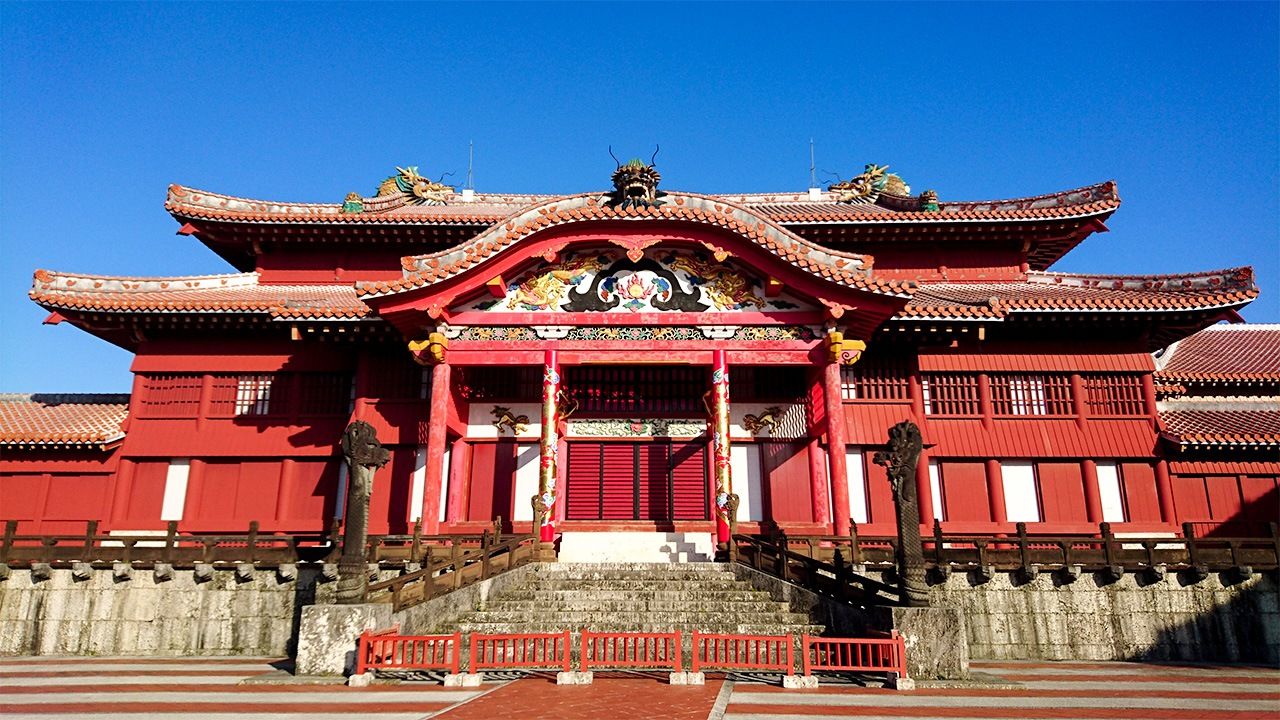
Okinawa: The Unique Culture of the Ryūkyū Islands
Culture- English
- 日本語
- 简体字
- 繁體字
- Français
- Español
- العربية
- Русский
A Hub of Maritime Asia
For 450 years, the Ryūkyū Kingdom flourished as an independent state that governed the Nansei islands in what is now the southernmost part of Japan. This small maritime nation, made up of a string of islands between Kyūshū and Taiwan, became a tributary state of Ming China in the second half of the fourteenth century, and developed into a major entrepôt on the East Asian trade routes, importing and reselling articles from nations across East and Southeast Asia.
The Bankoku shinryō no kane (Bridge of Nations bell) was cast in 1458, during the reign of Shō Taikyū (1415–60), sixth ruler of the first Shō dynasty. The bell carries an inscription in classical Chinese that describes Ryūkyū as an island like the legendary Mount Penglai (Hōrai) in the southern seas, an island paradise that has imported the finest items of culture from Korea and enjoys close relations with Japan and China. It is a bridge between the nations, and treasures from foreign lands fill the kingdom. The inscription gives a glimpse of the prosperity that flowed into the islands through trade. The development of the kingdom as a trading nation made Ryūkyū into a place of exchange, bringing together people, goods, and information from surrounding lands. This cosmopolitan setting was a major factor in the development of a distinctive culture in the islands.
But Ryūkyū was vulnerable to change. From the second half of the sixteenth century, the development of the Iwami Ginzan silver mine in the westernmost part of Honshū caused a silver rush across East Asia that led to the rise of lively private maritime trading. One result was the decline of places like Okinawa, which had thrived as intermediary links on the official international trading system. In 1609, the Shimazu clan of Satsuma in southern Kyūshū invaded Okinawa, and the islands were incorporated into Japan’s feudal system, even while continuing their formal relationship with China. To replace the declining revenue from international trade, the islands turned to producing and exporting unrefined sugar and turmeric. These changes transformed Ryūkyū into a new kind of society, which continued to exist as a small state between the behemoths of Japan and China until 1879, when it was formally annexed into the modern Meiji state as Okinawa Prefecture.
International Trade Nurtures a Unique Fusion Culture
One of the characteristics of Ryūkyū culture was the way in which it mixed together elements from different cultural sources. For example, official writs of appointment (jireisho) issued by the court in the sixteenth century used a unique combination of different scripts and styles from throughout East Asia. The main body of the text was written using Japanese hiragana, but the documents used the Ming calendrical system and were stamped with the royal seal (the Shuri seal) in the upper left and right corners of the document, Chinese style. The format of these stamps and documents was influenced by official edicts issued by Ming China and the royal court in Korea. In Japan, hiragana was never used in official documents, which were written in a Japanese version of classical Chinese. The Ryūkyū documents were unique, and written in a style that did not exist in either China or Japan.
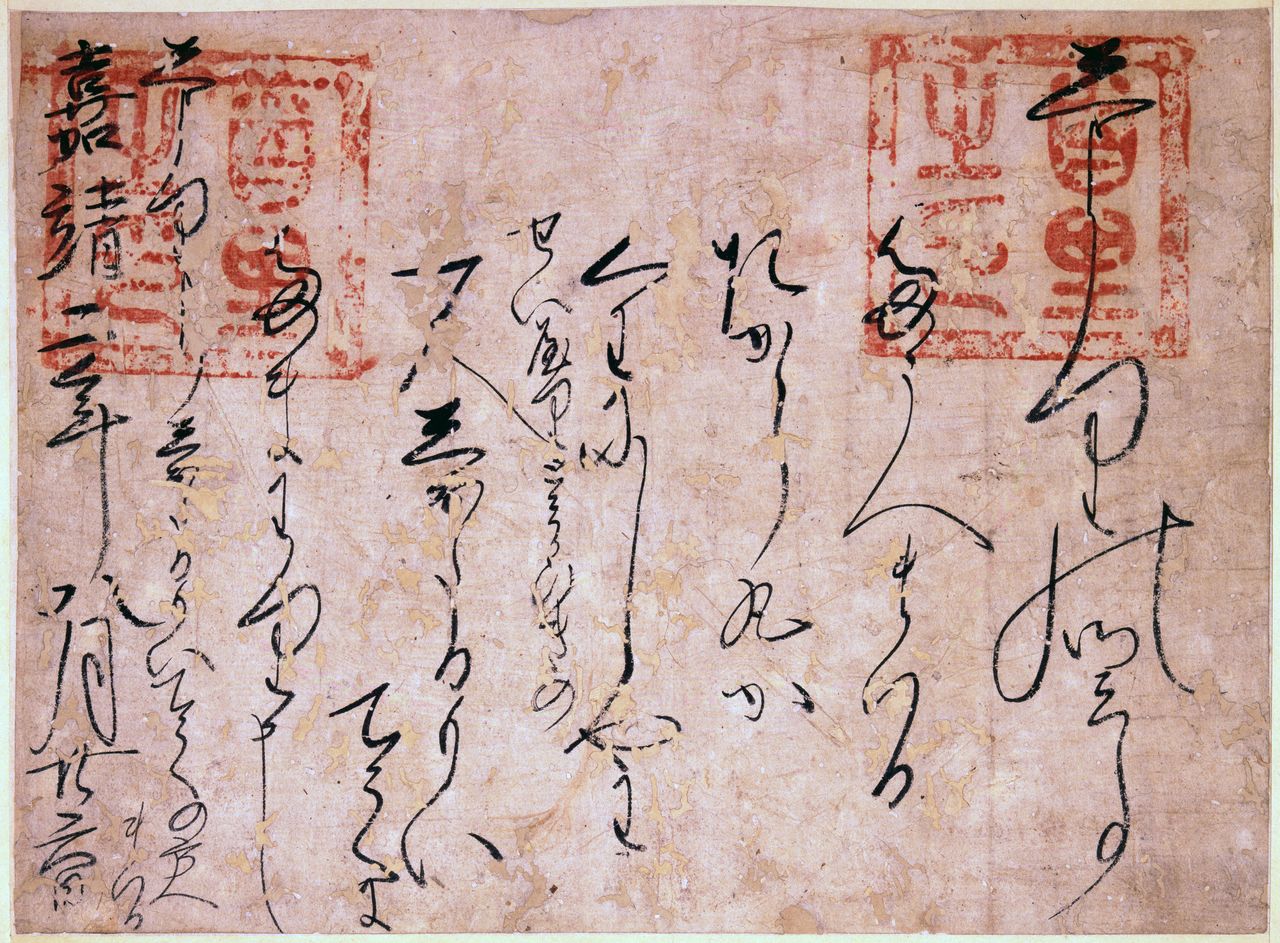
Dana family clan document no. 1. This is an official letter (jireisho) appointing the bearer to the crew of the Takara-maru, a ship that would take part in an official diplomatic voyage to China. The text is written in hiragana but uses a Chinese date and is stamped with the “Shuri seal” at top left and right, in the Chinese style. (In the collection of the Okinawa Prefectural Museum and Art Museum)
A similar phenomenon can be seen in religion, where Ryūkyū fused elements from many different traditions. The jinja (Shintō) worship in the islands was strongly influenced by the Kumano traditions centered on Wakayama Prefecture, while numerous tira (temple) dedicated to bijuru (sacred stones) and gungin (Japanese gongen; incarnation or manifestation of a Buddha in the form of a kami deity) can also be found throughout the islands. The word tira refers to a place of prayer that is somewhat different from a Buddhist temple (the sense of the Japanese cognate, tera). In terms of Buddhism, faith in Kannon (Avalokiteśvara, the bodhisattva of mercy) has a rich history in Okinawa, where images of the bodhisattva often became merged with the Chinese sea goddess Mazu. In the indigenous religion, noro priestesses worship the goddess Benzaiten as the protective deity of Kikoeōkimi, the highest ranking royal noro princess.
These are all linked closely to various forms of religious tradition indigenous to the islands, including faith in “other worlds,” sacred stones, and the feminine nature of spiritual power. One aspect of the Kumano faith is a belief in a pure world called Fudaraku (Sanskrit: Polataka) located somewhere in the southern seas. This bears a close resemblance to the Okinawan beliefs in “Niraikanai,” believed to be located somewhere far beyond the seas of Okinawa. The strong belief in the power of various goddesses, including Kannon, Benzaiten, and Mazu, is also influenced by the ancient Onari faith, which believed that spiritual power is the domain of women. An interesting example of this syncretism is the legend describing the origin of the gungin at Futenma, which incorporates elements of a folktale narrative associated with the Chinese sea goddess Mazu. This is just one example of how the different strands of culture and thought that were brought to the islands along the trade routes were woven into new forms here to create something distinctive and new.
A Ruling Class that Cultivated the Arts
Beginning in the late seventeenth century, Ryūkyū culture was given a new role in the governance of the country. According to the Haneji shioki, a compilation of rulings issued during the time of Haneji Chōshū (1617–1676) as sesshō or prime minister, the Ryūkyū elites were expected to study calligraphy and poetry, the way of tea, flower-arranging, music, and the culinary arts. In other words, unlike the Japanese samurai, the elites of the Ryūkyū Kingdom were expected to prioritize cultural accomplishments over the military arts.
Drama, music, and the applied arts developed among the ruling class centered on the castle at the kingdom’s capital at Shuri, now part of Naha. These art forms did not develop according to the preferences and tastes of individual artists and patrons; rather, they were supervised and directed by the royal government. The local elite was responsible for cultivating the performing traditional arts, and all the dancers were men. In 1719, a performance was given at Shuri Castle to entertain an important emissary from China who had come to witness and recognize the accession to the throne of the new king. This was the first performance of what later became kumiodori, the traditional Okinawan musical theater that is now inscribed on UNESCO’s list of world intangible cultural heritage.
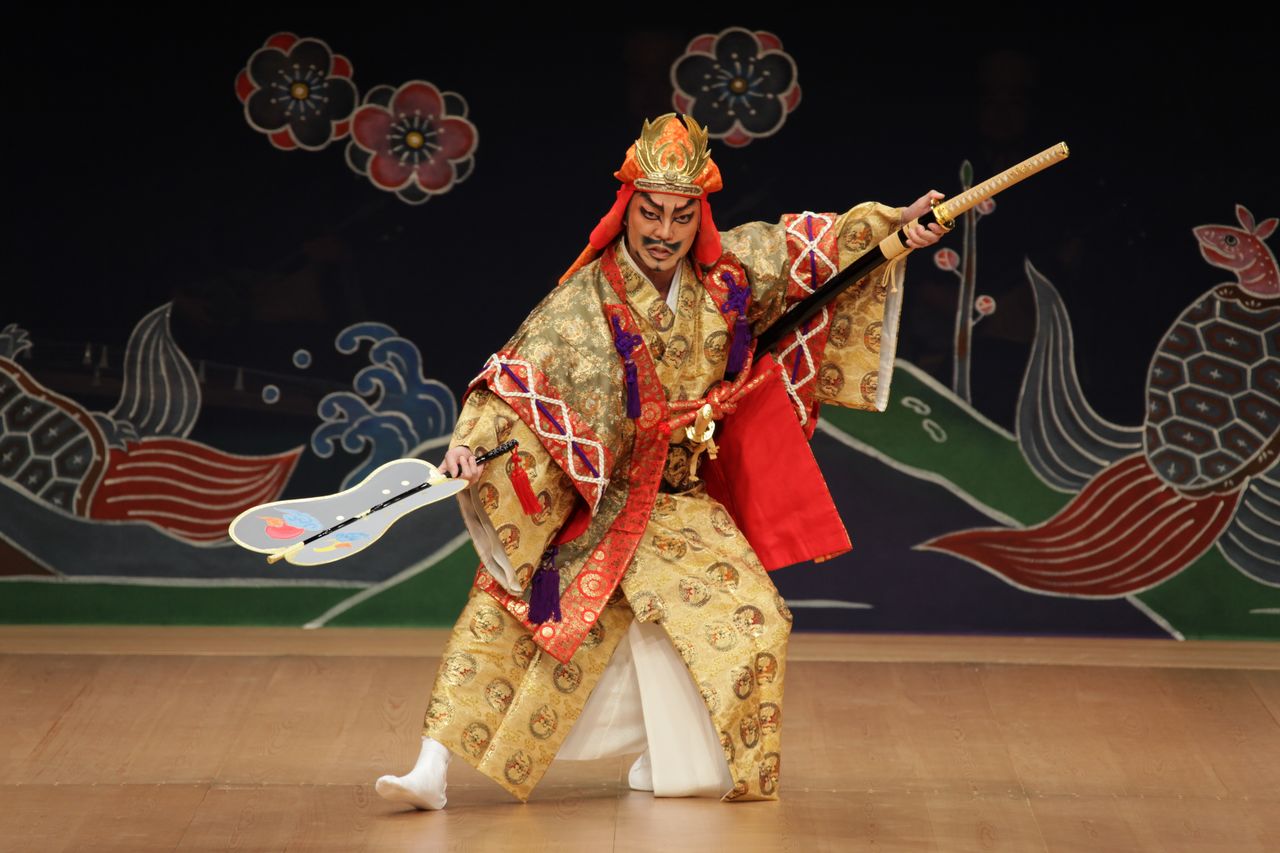
A scene from Nidō tekiuchi, one of the best-known examples of kumiodori. The drama is based on the story of Amawari, who raised an insurgency in the fifteenth century and was avenged by the orphaned sons of his adversary, the loyal retainer Gosamaru. (Courtesy of the National Theater Okinawa)
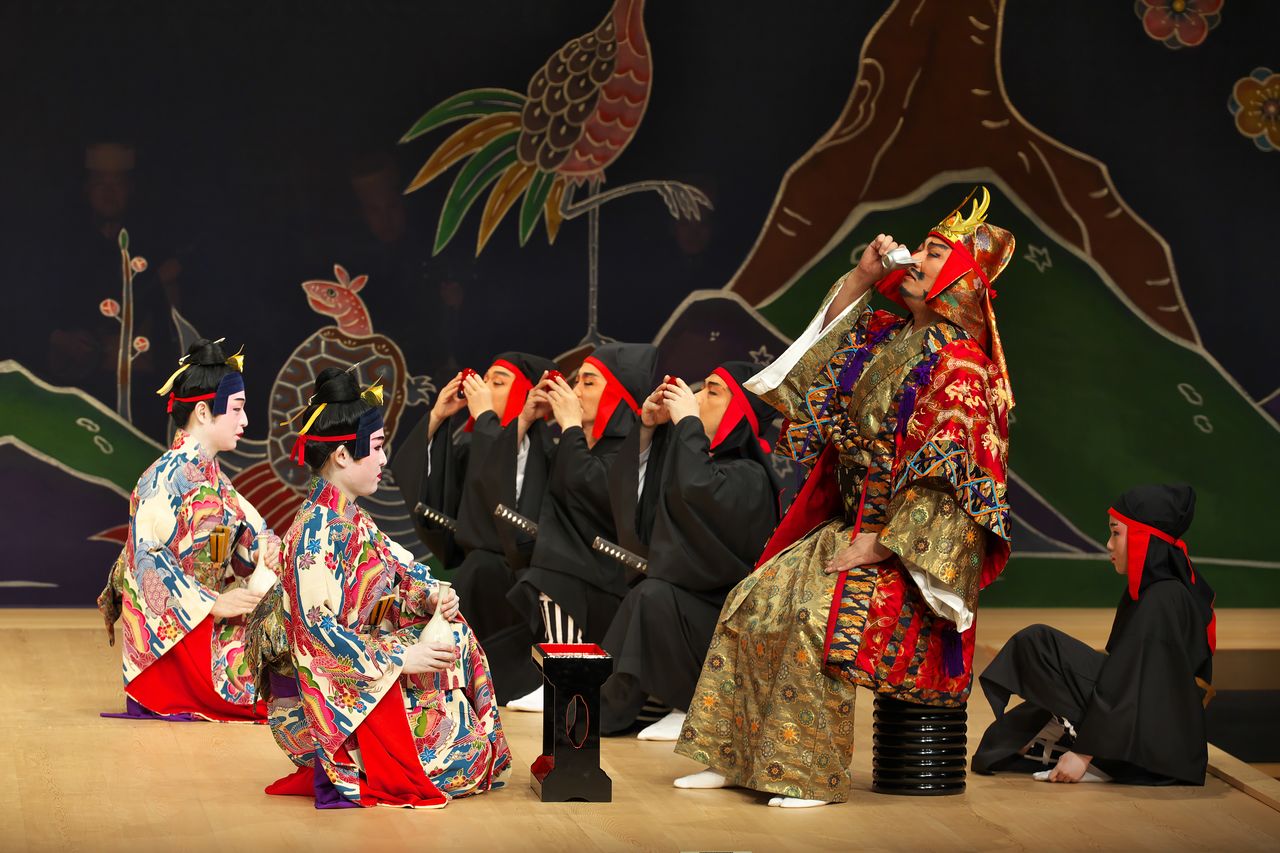
A scene from Nidō tekiuchi. Burning with an ambition to seize control of the kingdom, Amawari (right) destroys his rival Gosamaru, who is avenged by his two sons (left). (Courtesy of the National Theater Okinawa)
The Ryūkyū government even had an official known as the magistrate of dance (odori bugyō) who specialized in the entertainments put on for Chinese investiture envoys and other guests of honor. One of the best-known figures to occupy this position was Tamagusuku Chōkun (1684–1734), who is credited with creating kumiodori. The dance-drama continued to develop and eventually assumed the proud position it occupies today as Okinawa’s traditional dramatic art form. Kumiodori consists of music, drama, words, and dance. It was based on old legends from Japan, China and Ryūkyxu folk tales, and also incorporated elements from neighboring traditions, including nō, kyōgen, and kabuki, and the “Min opera” tradition of Fujian. In the dramatic arts too, Ryūkyū embraced a rich fusion of elements from the different cultural traditions of the region.
Using Soft Power to Secure an International Position
Representatives from Ryūkyū joined the feudal lord of Satsuma on his visits to Edo to demonstrate allegiance to the shōgun at Edo Castle. Among the delegation that traveled to Edo from the islands were officials specializing in drama and music, who performed traditional Ryūkyū dances before the shōgun and daimyō, or feudal lords. In particular, attractive young men from the Shuri elite charmed and astonished people in Edo and other places they passed through on their long journey north, and were feted as idols wherever they went.
These official tribute missions also led to intellectual and cultural exchanges between Ryūkyū and Japan. During his time in Japan, Tei Junsoku (1663–1735), known as the “sage of Nago,” developed relationships with people like Arai Hakuseki (1657–1725) and the regent Konoe Iehiro (1667–1739). The poem Tei composed when he was invited by Konoe at his villa (“Butsugai rōki”) is a part of the Yōmei Bunko archive in Kyoto today. Tei Junsoku also played an important role by presenting to the shōgun a copy of Six Courses in Morals (Riku yuengi), which he had brought back with him from his time studying in China. This book of moral instruction was later widely used in terakoya temple schools throughout the country during the Edo period (1603–1867). In this way, Ryūkyū had a profound impact on the formation of Japanese ethics during the period.
The diplomatic role played by the arts was not limited to music and drama. The applied arts also played a similar role. Perhaps the most representative example of Okinawan arts and crafts is lacquerware, particularly kaizuri items inlaid with mother-of-pearl. Lacquerware was produced under government control, and was used as official gifts on diplomatic missions. Today, examples of lacquerware that were used for diplomatic purposes during this period can be found in the collections of the Tokugawa Art Museum in Nagoya and the Forbidden City in Beijing. Again, these masterpieces were not created freely by individual artists. Officials in the Kaizuri bugyōsho decided the designs and style of the pieces, which were then produced by private artisans and submitted to the government. The climate of Okinawa is ideal for lacquerware production, and the Ryūkyū Kingdom produced many outstanding examples of lacquerware.
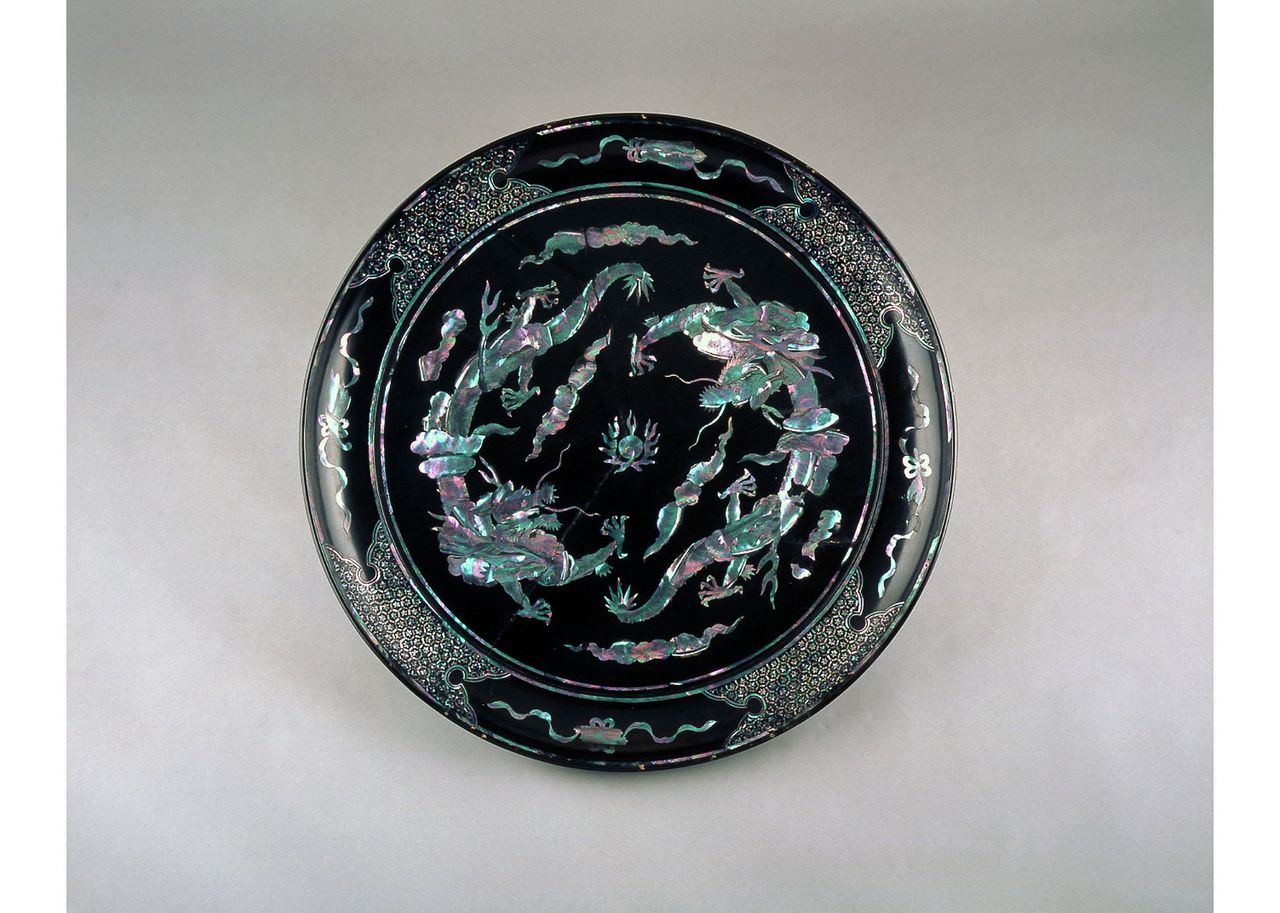
Large plate tray with unryū cloud dragons in mother-of-pearl on black lacquer. This piece dates from the late eighteenth or early nineteenth century. The auspicious design shows a pair of dragons emerging from clouds bearing wish-fulfilling jewels. (In the collection of the Urasoe Art Museum)
Fengshui and the Traditional Village Scenery of Okinawa
Paradoxically, the period of Satsuma rule saw the culture of the islands undergo significant change as Chinese culture made itself felt more strongly in the islands than ever before. Confucianism became a state ideology, and fengshui and other aspects of Chinese philosophy were introduced. During the eighteenth century, villages were reorganized in line with fengshui principles, giving birth to the grid pattern layouts and lines of fukugi trees that are such an essential part of the Okinawa landscape today. Other familiar aspects of Okinawan culture became widespread under influence from southern China during this period, including shīsā (guardian lions), the ishigantō stones placed at T-junction intersections to ward off evil spirits, and kamekō-baka turtleback tombs.
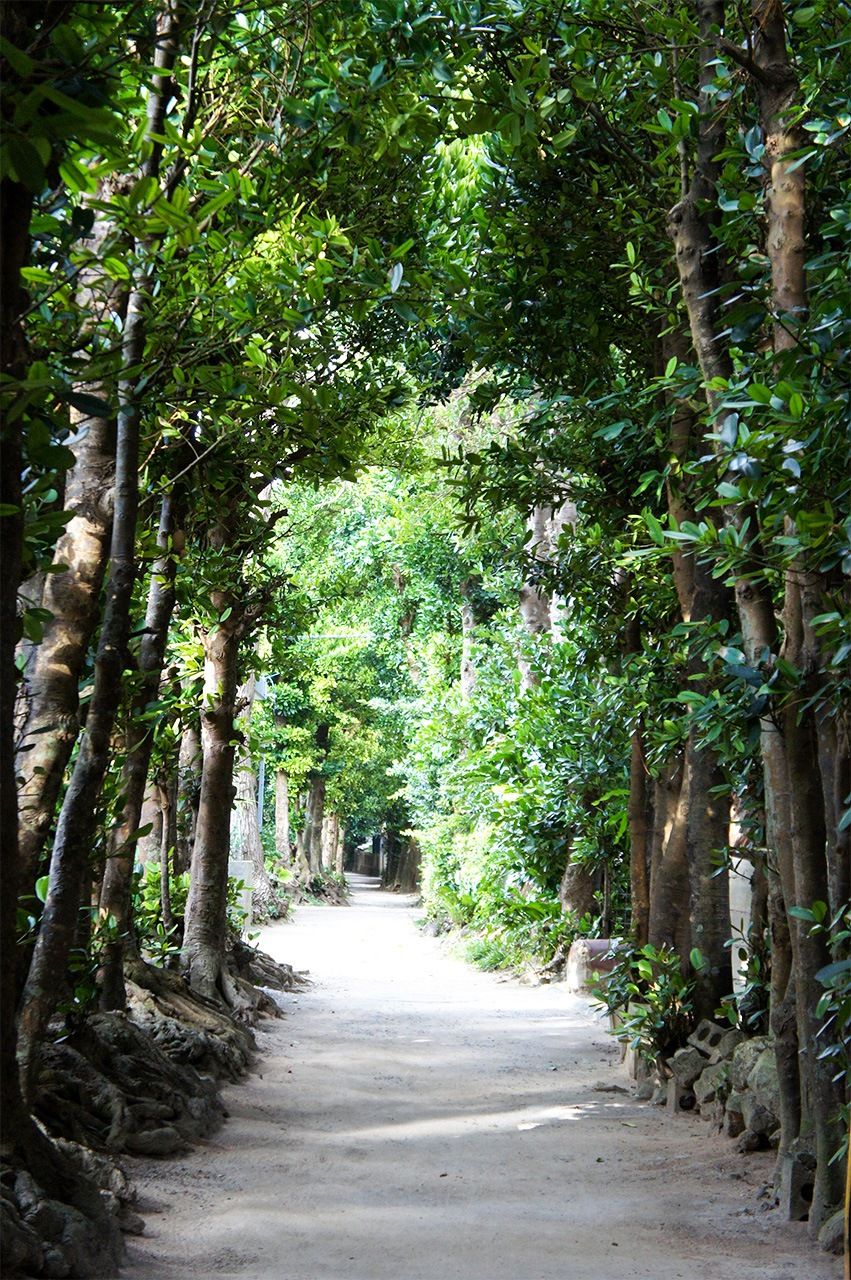
Scenes like this, showing a line of fukugi trees planted along a straight road arranged in a traditional grid pattern according to fengshui principles, would have been a common sight in villages throughout the Ryūkyū islands in the eighteenth and nineteenth centuries. These lines of trees also served as a defense against frequent typhoons. (Photo by the author)
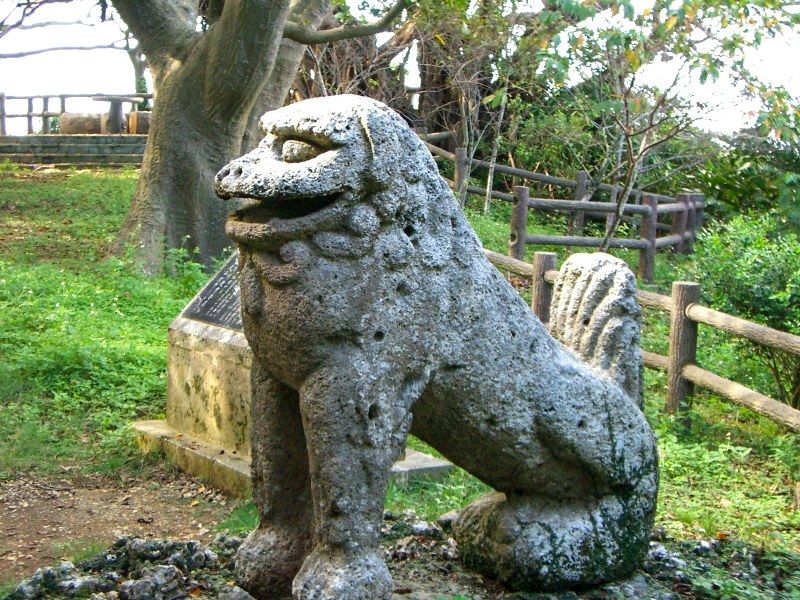
Shīsā guardian deities became widespread in villages during the early modern period. Beginning in the Meiji era (1868–1912) they began to appear on roof tiles as well. (Photo by the author)
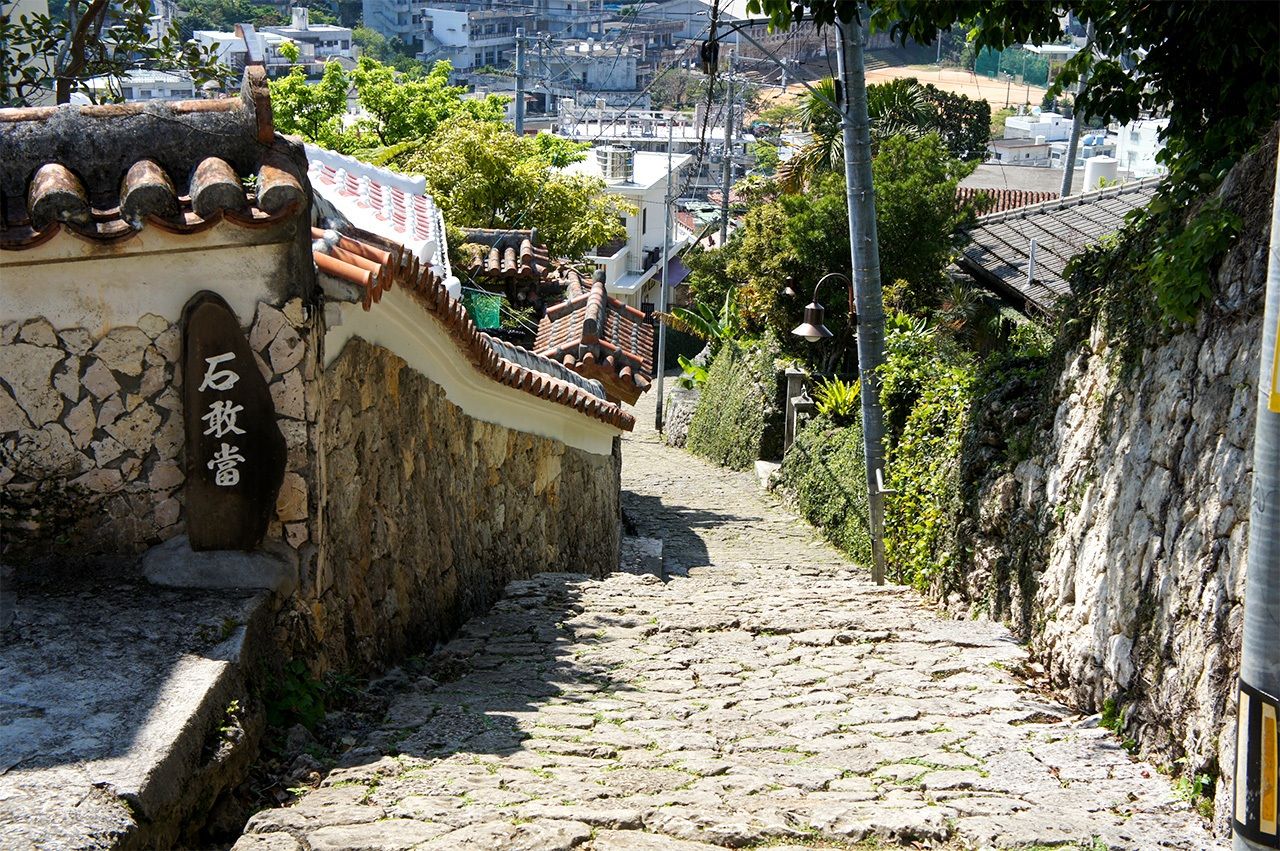
Stone crossroad amulets known as ishigantō originated in China. They are placed at T- and Y-shaped intersections to ward off evil spirits. (Photo by the author)
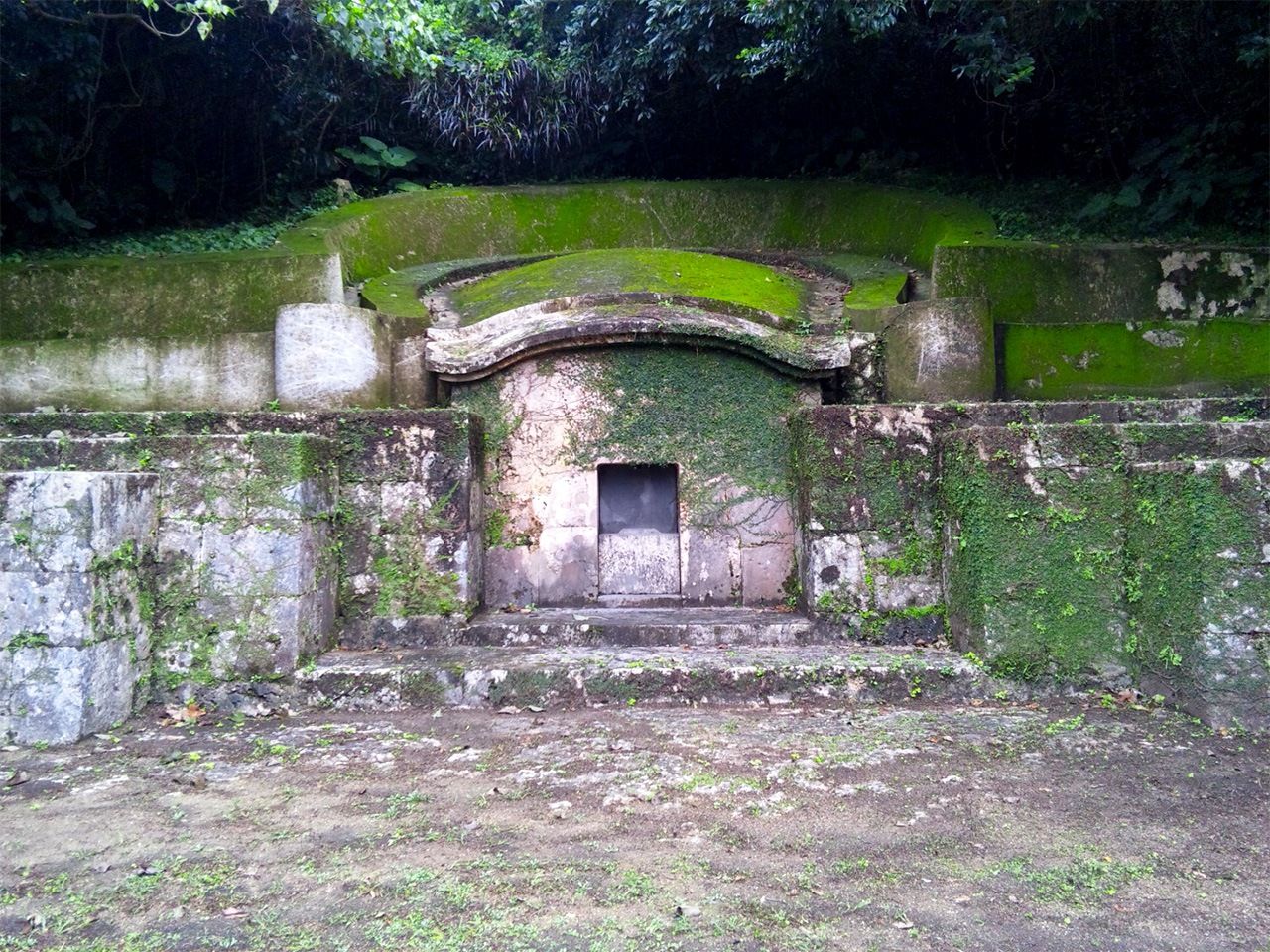
A kamekō-baka (turtleback tomb). These started to be built in the islands in the second half of the seventeenth century. They are thought to have originated in Fujian. They are not individual graves but family crypts. (Photo by the author)
The position of Shuri castle was also interpreted according to fengshui principles, along with the city grew up developed around it. Central to the practice of fengshui in Ryūkyū was the idea of hōgō or “embrace.” In Okinawa, trees were planted to create a barrier around houses and secure positive energy or qi. Trees were planted in large numbers on the hills around Shuri Castle, in order to trap qi in the castle and the surrounding town.
Annexation and the Transition from Court Culture to Popular Pursuits
After the Ryūkyū Kingdom came to an end in 1879, the court culture that had thrived in and around Shuri dispersed from the capital and spread out into the countryside, taking root in the lives of ordinary people. Members of the elite who had lost their positions as government officials took private jobs as entertainers, writing Okinawan dramas and folksongs that became part of popular entertainment among the people of the islands. Kumiodori spread from its original base in the capital to other parts of the new prefecture, including the outer islands, and survives to this day as a distinctive and highly localized form of theatrical art. Okinawa is sometimes called the “island of the dramatic arts.” The islands’ unique historical background is one of the main reasons why this rich tradition developed the way it did. Likewise, lacquerware artisans who had lost their main patron now that the royal court was no more took to satisfying the demands and tastes of ordinary people to make a living.
The Battle of Okinawa in 1945 was a disaster for the islands. Along with the thousands of lives lost, the conflagration of war laid waste to cultural treasures built up over centuries. Shuri Castle and many other historical buildings were reduced to rubble and ash, and after the war Okinawan culture had to start again from nothing. Musicians cobbled together improvised sanshin (a traditional three-stringed instrument) by reusing cans salvaged from the US Army, and performances began again. Artisans making bingata, the traditional dyed textiles of the islands, worked to restore pieces by relying on patterns that had escaped destruction outside the prefecture and using empty cartridge cases as the tube tips for the conical bags containing the starch used in the resist dyeing process. Thanks to the efforts of the survivors, Okinawan culture was brought back to life and nurtured, and it flourishes again today. When we consider the culture of Okinawa and the Ryūkyū islands, we should never forget that it has not simply existed in tranquility throughout the centuries—its survival today is thanks to the sacrifice of the people of the islands, who worked to ensure that their culture emerged unbowed from tragedy and adversity.
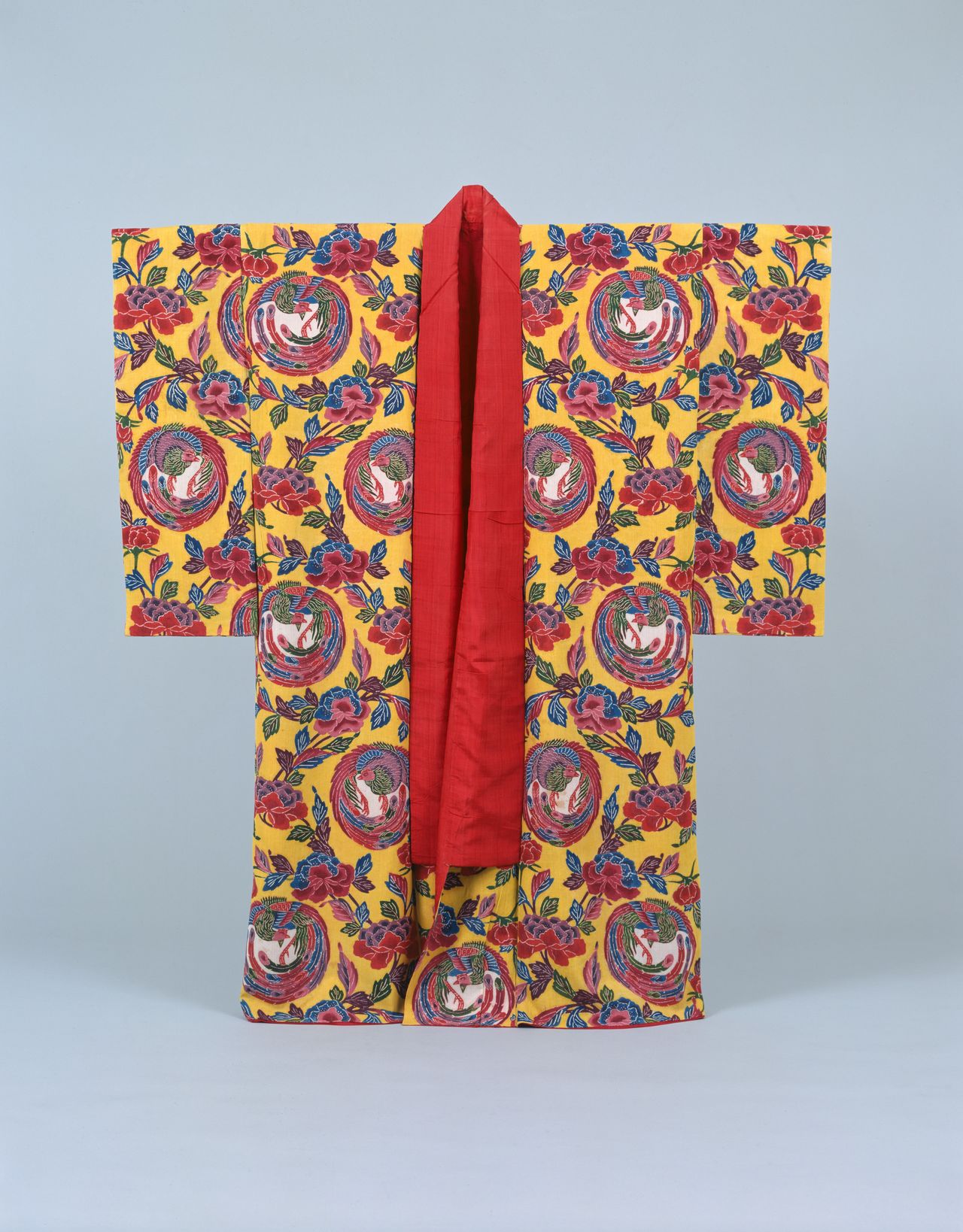
Lined silk crepe bingata kimono with phoenix and peony design on a yellow background. This would have been worn by boys of the ruling class before their coming-of-age ceremony. The vibrant yellow was achieved using orpiment, a toxic sulfide mineral used as a dye. (In the collection of the Naha City Historical Museum).
(Originally published in Japanese. Banner photo: The seiden or main hall of Shuri Castle, the symbol of Ryūkyū culture. The distinctive architecture, unique to the islands, incorporates elements of traditional Chinese and Japanese styles. The structure was completed in 1992, modeled on an earlier rebuild from 1715. The building was destroyed by fire on October 31, 2019. © Jiji.)